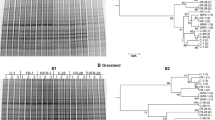Abstract
Changes in microbial biomass and activity were determined in a sandy-loam soil treated with successive dosages of oxytetracycline (a bactericide) or captan (a fungicide) throughout 98 days of incubation under laboratory conditions. The numbers of culturable bacteria and fungi, total bacterial and fungal biomass (as amounts of phospholipid fatty acids, PLFA), the fungal/bacterial ratio, activities of acid and alkaline phosphatases and urease as well as concentrations of N-NH4 + and N-NO3 − were assessed. Both oxytetracycline and captan significantly decreased numbers of culturable bacteria whereas total bacterial biomass (bactPLFA) was not affected. Oxytetracycline did not effect on the fungal biomass, however their numbers were reduced after the first and second time of soil amendment with the bactericide. Conversely, fungal numbers and biomass (PLFA 18:2ω6,9) significantly decreased in response to soil treatment with the fungicide. Compared to oxytetracycline, captan significantly decreased activities of acid and alkaline phosphatases. For urease activity, the decreased activity was only observed in the soil after the third dosage of captan. Both biocides significantly increased concentrations of N-NH4 + and decreased concentrations of N-NO3 − after the soil treatments. The results of this study indicate that successive soil treatment with oxytetracycline or captan dosages may negatively affect non-target soil microorganisms and their activities.



Similar content being viewed by others
References
Alef K, Beck T, Zelles L, Kleiner D (1988) A comparison of methods to estimate microbial biomass and N-mineralization in agricultural and grassland soils. Soil Biol Biochem 20:561–565. doi:10.1016/0038-0717(88)90073-9
Alef K, Nannipieri P, Trazar-Cepeda C (1995) Phosphatase activity. In: Alef K, Nannipieri P (eds) Methods in applied soil microbiology and biochemistry. Academic Press, London, pp 335–344. ISBN: 0-12-513840-7
Bailey VL, Smith JL, Bolton H Jr (2002) Fungal-to-bacterial ratios in soils investigated for enhanced C sequestration. Soil Biol Biochem 34:997–1007. doi:10.1016/S0038-0717(02)00033-0
Bailey VL, Smith JL, Bolton H Jr (2003) Novel antibiotics as inhibitors for the selective respiratory inhibition method of measuring fungal:bacterial ratios in soil. Biol Fertil Soils 38:154–160. doi:10.1007/s00374-003-0620-7
Bossuyt H, Denef K, Six J, Frey SD, Merckx R, Paustian K (2001) Influence of microbial populations and residue quality on aggregate stability. Appl Soil Ecol 16:195–208. doi:10.1016/S0929-1393(00)00116-5
Chen SK, Edwards CA (2001) A microcosm approach to assess the effects of fungicides on soil ecological processes and plant growth: comparisons of two soil types. Soil Biol Biochem 33:1981–1991. doi:10.1016/S0038-0717(01)00132-8
Chen SK, Edwards CA, Subler S (2001) Effects of the fungicides benomyl, captan and chlorothalonil on soil microbial activity and nitrogen dynamics in laboratory incubations. Soil Biol Biochem 33:1971–1980. doi:10.1016/S0038-0717(01)00131-6
Colinas C, Ingham E, Molina R (1994) Population responses of target and non-target forest soil organisms to selected biocides. Soil Biol Biochem 26:41–47. doi:10.1016/0038-0717(94)90193-7
Cycoń M, Piotrowska-Seget Z, Kaczyńska A, Kozdrój J (2006) Microbiological characteristics of a sandy loam soil exposed to tebuconazole and λ-cyhalothrin under laboratory conditions. Ecotoxicology 15:639–646. doi:10.1007/s10646-006-0099-8
Díaz-Raviña M, Bååth E, Martín A, Carballas T (2006) Microbial community structure in forest soils treated with a fire retardant. Biol Fertil Soils 42:465–471. doi:10.1007/s00374-005-0036-7
Frostegård A, Bååth E (1996) The use of phospholipids fatty acid analysis to estimate bacterial and fungal biomass in soil. Biol Fertil Soils 22:59–65. doi:10.1007/BF00384433
Frostegård A, Tunlid A, Bååth E (1991) Microbial biomass measured as total lipid phosphate in soils of different organic content. J Microbiol Methods 14:151–163. doi:10.1016/0167-7012(91)90018-L
Gianfreda L, Sanninio F, Ortega N, Nannipieri P (1994) Activity of free and immobilized urease in soil: effects of pesticides. Soil Biol Biochem 26:777–784. doi:10.1016/0038-0717(94)90273-9
Halling-Sørensen B, Sengeløv G, Ingerslev F, Jensen LB (2003) Reduced antimicrobial potencies of oxytetracycline, tylosin, sulfadiazin, streptomycin, ciprofloxacin, and olaquindox due to environmental processes. Arch Environ Contam Toxicol 44:7–16. doi:10.1007/s00244-002-1234-z
Hund-Rinke K, Simon M, Lukow T (2004) Effects of tetracycline on the soil microflora: function, diversity, resistance. J Soils Sediments 4:11–16
Ingham EM, Parmalee R, Coleman DC, Crossley DA Jr (1991) Reduction of microbial and faunal groups following application of streptomycin and captan in Geargia non-tillage agroecosystems. Pedobiologia (Jena) 35:297–304
Martínez-Toledo MV, Samerón V, Rodelas B, Pozo C, González-López J (1998) Effects of the fungicide captan on some functional groups of soil microflora. Appl Soil Ecol 7:245–255. doi:10.1016/S0929-1393(97)00026-7
McManus PS, Stockwell VO, Sundin GW, Jones AL (2002) Antibiotic use in plant agriculture. Annu Rev Phytopathol 40:443–465. doi:10.1146/annurev.phyto.40.120301.093927
Monkiedje A, Spiteller M (2002) Effects of the phenylamide fungicides, mefenoxam and metalaxyl, on the microbiological properties of a sandy loam and a sandy clay soil. Biol Fertil Soils 35:393–398. doi:10.1007/s00374-002-0485-1
Schmitt H, Stoob K, Hamscher G, Smit E, Seinen W (2006) Tetracyclines and tetracycline resistance in agricultural soils: microcosm and field studies. Microb Ecol 51:267–276. doi:10.1007/s00248-006-9035-y
Singh BK, Walker A, Wright DJ (2002) Persistence of chlorpyrifos, fenamiphos, chlorothalonil, and pendimethalin in soil and their effects on soil microbial characteristics. Bull Environ Contam Toxicol 69:181–188. doi:10.1007/s00128-002-0045-2
Thiele-Bruhn S (2003) Pharmaceutical antibiotic compounds in soils—a review. J Plant Nutr Soil Sci 166:145–167. doi:10.1002/jpln.200390023
Winckler C, Grafe A (2001) Use of veterinary drugs in intensive animal production: evidence for persistence of tetracycline in pig slurry. J Soil Sediments 1:66–70
Author information
Authors and Affiliations
Corresponding author
Rights and permissions
About this article
Cite this article
Piotrowska-Seget, Z., Engel, R., Nowak, E. et al. Successive soil treatment with captan or oxytetracycline affects non-target microorganisms. World J Microbiol Biotechnol 24, 2843–2848 (2008). https://doi.org/10.1007/s11274-008-9815-2
Received:
Accepted:
Published:
Issue Date:
DOI: https://doi.org/10.1007/s11274-008-9815-2




